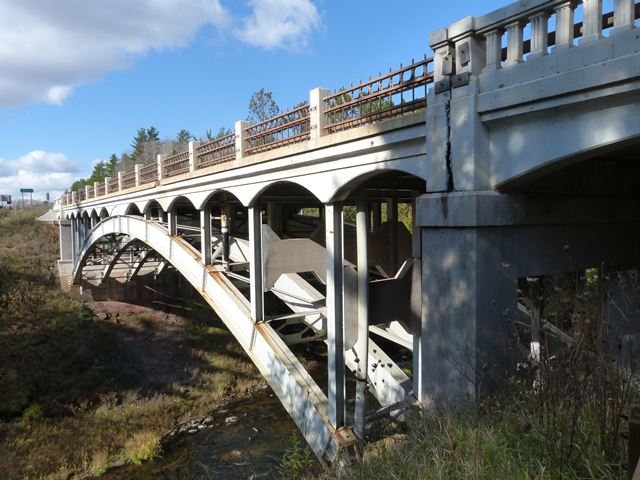We Recommend:
Bach Steel - Experts at historic truss bridge restoration.
BridgeHunter.com Phase 1 is released to the public! - Visit Now
Agate Falls Bridge

Primary Photographer(s): Nathan Holth
Bridge Documented: October 1, 2012
Rural: Ontonagon County, Michigan: United States
Metal Two-Hinged Solid Ribbed Deck Arch, Fixed and Approach Spans: Concrete Slab, Fixed
1930 By Builder/Contractor: Meads and Anderson and Engineer/Design: Michigan State Highway Department
1992
150.0 Feet (45.7 Meters)
193.0 Feet (58.8 Meters)
32.2 Feet (9.81 Meters)
1 Main Span(s) and 2 Approach Span(s)
8491

View Information About HSR Ratings
Bridge Documentation
View Archived National Bridge Inventory Report - Has Additional Details and Evaluation

This bridge is one of a couple magnificent steel deck arch bridges found in the Upper Peninsula. Highway bridges of this structure type are otherwise essentially unheard of in Michigan. The older of the two in the U.P., this bridge displays an well-decorated design typical of the period in which it was constructed. The bridge structure itself is relatively simple in appearance, its beauty derived from the graceful appearance of the solid ribbed arch, which is a riveted built-up beam. At the same time, there is complexity to the bridge as well, mostly in the form of the bracing system. Between the arch ribs are steel braces composed of angles arranged in a lattice pattern. There are concrete diaphragms between the columns of the bridge. Compared with other steel arch bridges nationwide, these diaphragms are unusual since they are concrete. However, in the context of the Michigan State Highway Department, they are less unusual. The Department also used concrete diaphragms on the steel stringer bridges it was building during this period. It appears the Department simply applied this practice to its steel arch bridge construction as well. The bridge's short concrete approach spans contain concrete balustrade railings, a standard design used extensively by the Michigan State Highway Department (MSHD) during a relatively short period between 1927 and 1932. The main span of the bridge features a unique ornate metal railing design that was a standard design that MSHD used for a few years, but of which very few examples remain today. Perhaps the most distinctive architectural feature of the bridge is the concrete arch shapes that span between each column just below the deck, providing a visual compliment to the shape of actual arch span. These arches also hide the different structure type of the tiny approach span at each end of the bridge, bringing visual continuity to the bridge. This bridge could be counted among the most beautiful bridges designed by the MSHD. In more recent years, the bridge was rehabilitated with an effort made to preserve the elements of the bridge with historic significance. As such, the original metal railings remain, and other architectural details have been maintained. The steel arch also shows no signs of major alteration from the original design. The bridge is surrounded by the Agate Falls State Scenic Site and a walkway under the bridge makes it easy for even casual visitors or visitors to the scenic site who may not be aware of the historic design of this bridge to see the arch and its details up close. The bridge's significance has been recognized as it is designated a Michigan Historic Civil Engineering Landmark.
![]()
Photo Galleries and Videos: Agate Falls Bridge
Bridge Photo-Documentation
Original / Full Size PhotosA collection of overview and detail photos. This gallery offers photos in the highest available resolution and file size in a touch-friendly popup viewer.
Alternatively, Browse Without Using Viewer
![]()
Bridge Photo-Documentation
Mobile Optimized PhotosA collection of overview and detail photos. This gallery features data-friendly, fast-loading photos in a touch-friendly popup viewer.
Alternatively, Browse Without Using Viewer
![]()
Maps and Links: Agate Falls Bridge
Coordinates (Latitude, Longitude):
Search For Additional Bridge Listings:
Bridgehunter.com: View listed bridges within 0.5 miles (0.8 kilometers) of this bridge.
Bridgehunter.com: View listed bridges within 10 miles (16 kilometers) of this bridge.
Additional Maps:
Google Streetview (If Available)
GeoHack (Additional Links and Coordinates)
Apple Maps (Via DuckDuckGo Search)
Apple Maps (Apple devices only)
Android: Open Location In Your Map or GPS App
Flickr Gallery (Find Nearby Photos)
Wikimedia Commons (Find Nearby Photos)
Directions Via Sygic For Android
Directions Via Sygic For iOS and Android Dolphin Browser
USGS National Map (United States Only)
Historical USGS Topo Maps (United States Only)
Historic Aerials (United States Only)
CalTopo Maps (United States Only)

